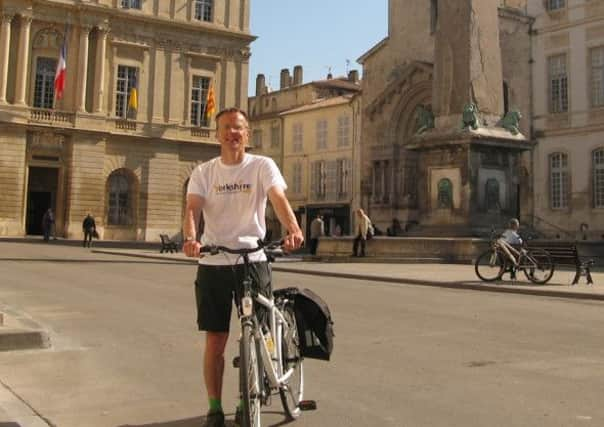Pedalling Provence


I cycled past the Arc de Triomphe on the first day of my tour of France rather than the last. My arch was about 1,800 years older than the more famous one in Paris and 370 miles to the south at the formal entrance to the Roman town of Glanum in Provence.
Later, from the viewpoint overlooking the ruins I could see a jumble of baths, temples and pavements. Looming behind were Les Alpilles, a range of precarious pinnacles that look like the surf of a wave about to engulf the plain and, in the far distance, I could just make out the shape of Mont Ventoux. At 1,900 metres, it is a notorious climb often included in the world’s greatest bike race and the place where my brother was later heading for his taste of Le Tour.
Advertisement
Hide AdAdvertisement
Hide AdI had humbler ambitions and was on a gentle ride from Tarascon to the Mediterranean coast.
Ancient Rome – Provence is so-called because the region was formerly the province of Rome – was one of three themes of my journey. The following day I came across the remains of an aqueduct that used to channel spring water from Les Alpilles via a water tower in Arles to the city’s private villas. The structure straddles the road like a tank wall. At its far end I passed through a cleft of rock for a surprise view over a vast plain, much of it covered with rice fields.
The greatest concentration of Roman ruins comes at Arles, my second stopover. Located on the banks of the Rhône, Arles is a classy, compact city with huge amphitheatre (used today for bullfighting), spooky, dripping catacombs, thermal baths and other architectural gems, all of which I explored on a self-guided walking tour. It ended at a monument to Van Gogh. He is depicted earless, bodyless and with one tooth and, as such, looks like a Hallowe’en fright mask. The Dutch artist, who provides the second theme of the tour, lived in the city for a year in 1888/89 and spent a similar subsequent spell at a mental hospital in a former monastery in St Rémy de Provence which I’d visited the previous day. The floral cloister and walled garden packed with lavender would’ve been a soothing place for a troubled mind as, indeed, it is today. The hospital remains in use and painting is still a therapy.
A walk nearby links 21 of the 150 scenes painted by Van Gogh with a reproduction of each canvas in the appropriate spot. I was reminded of the paintings of Van Gogh-inspired David Hockney that depict his favourite places in the Yorkshire Wolds.
Advertisement
Hide AdAdvertisement
Hide AdThe last leg of the ride took me across a region as flat as the East Riding and where, similarly, practically the only settlements are farms protected by clumps of trees. The big difference of the Camargue, though, is the wildlife, the third theme of my trip. I experienced it from an eight-mile stoney track across the salt marshes and lagoons that form a giant and unique nature reserve. My journey suddenly became an adventure. A bike is a great vehicle for a safari when there are no man-eating animals around. You travel at just the right speed not to miss anything, you have all round vision, can hear and smell the environment and, in the Camargue, the insects are much less of a bother to a cyclist than a walker.
I’d soon seen the big three: white horses, black Camargue bulls (distinguished by their upcurved horns) and scores of flamingos. A pencil line of trees on the distant far side of Étang de Vaccarès was the only way I could tell which blue belonged to water and which to the sky. Other than the occasional rumble of a passing four-wheel drive all I could hear was birdsong. The Camargue is a twitcher’s paradise and the place to come if you like horseriding too.
The safari feel extended to my hotel, Les Arnelles, located just outside the seaside town of Saintes-Maries-de-la-Mer (Van Gogh was here too). The rooms are imaginatively and stylishly designed as chalets surrounding reed beds, with boardwalks connecting them, the main building and hotel’s riding centre. In place of a watering hole there is a mini-lagoon. As I dined pecking ducks created concentric circles in the surface of the water and the setting sun glowed through the manes of the white horses. You can almost swim with flamingos; they’re in one pool and you’re a few yards away in another.
On my final day, keen to escape the hustle and bustle of the town, I ventured out through the lagoons along the coast on a traffic-free track. With the tide out you could almost forget which side the sea was on. A lonely lighthouse doubled up as my destination and official finishing post. No yellow jersey, no personal best and certainly no king of the mountains but I’d had a grand tour of the history, culture and wildlife of western Provence.
Advertisement
Hide AdAdvertisement
Hide Ad• Paul Kirkwood was a guest of Inntravel based near Castle Howard. The new Impressions of the Camargue self-guided cycling holiday includes cycle hire, six nights accommodation and luggage transfer between hotels. Price around £850 per person based on two people sharing. Inntravel.co.uk.
Flights not included but available from Leeds-Bradford to Montpellier with Ryanair. Returns from under £100. Ryanair.com.